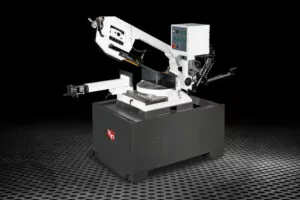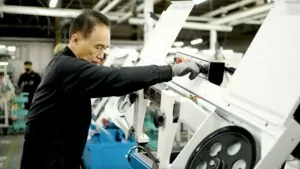Motor pulleys are a cornerstone of modern industrial machinery, playing a critical role in optimizing both energy efficiency and performance in band saws and milling machines. With industry forecasts predicting significant market growth and substantial cost savings through enhanced energy efficiency—as highlighted in this report from Verified Market Reports—it’s clear that understanding and selecting the right motor pulley is essential for achieving peak operational performance.
1. Understanding the Function of a Motor Pulley in Industrial Machinery
The motor pulley serves as a critical component in power transmission systems for industrial machinery. This wheel-shaped device attaches directly to the motor shaft and works as the initial point of power transfer in the machine’s drive system. In equipment like metal band saws and mill drill machines, the motor pulley initiates the transfer of rotational energy from the motor to the cutting mechanisms.
A properly functioning motor pulley system consists of several key components:
- The motor pulley (attached to the motor shaft)
- Drive belts (typically V-belts)
- Driven pulleys (connected to the machine components)
- Tensioning mechanisms
The design of a motor pulley directly impacts machine performance. Its diameter, material composition, and groove pattern all contribute to how effectively power transfers through the system. For precision machinery, even small variations in motor pulley specifications can significantly affect operational outcomes.
2. How Motor Pulleys Affect Performance in Band Saws and Milling Machines
The motor pulley plays a decisive role in determining the operational characteristics of both metal cutting bandsaws and mill drill machines. By changing the motor pulley size relative to the driven pulley, manufacturers can adjust the speed and torque delivered to the cutting mechanism. This relationship, known as the pulley ratio, fundamentally controls how the machine performs during operation.
| Pulley Ratio Effect | Smaller Motor Pulley | Larger Motor Pulley |
|---|---|---|
| Speed | Decreased cutting speed | Increased cutting speed |
| Torque | Increased cutting torque | Decreased cutting torque |
| Best Application | Hard materials, precision cuts | Softer materials, faster production |
In horizontal band saws, the motor pulley directly influences blade speed, which must be matched to the material being cut. Similarly, in mill drill machines, the motor pulley affects spindle speed, determining how effectively the machine can perform various milling operations.
3. Types of Motor Pulleys and Their Applications
Different machinery applications require specific types of motor pulleys. Understanding these variations helps in selecting the right component for optimal machine performance. The most common types include:
- Fixed-diameter pulleys: Standard in basic machinery with consistent speed requirements
- Step pulleys: Allow manual speed changes by moving the belt between different diameter sections
- Variable-speed pulleys: Provide continuous speed adjustment through movable flanges
- Timing pulleys: Feature teeth that engage with notched belts for precise power transmission
For metal cutting bandsaws, step pulleys are particularly common as they allow operators to select different speeds for various materials. Mill drill machines often utilize either step pulleys or variable-speed systems to accommodate the wide range of cutting speeds required for different operations and materials.
| Pulley Type | Advantages | Common Applications |
|---|---|---|
| Fixed-diameter | Simple, reliable, low maintenance | Basic band saws, single-purpose machines |
| Step pulley | Multiple speed options, cost-effective | General-purpose band saws and mill drills |
| Variable-speed | Infinite speed adjustment, no belt changes | Premium mill drill machines, precision applications |
| Timing pulley | No slippage, precise power transfer | CNC equipment, high-precision applications |
4. The Science Behind Motor Pulley Ratios
The relationship between motor pulley diameter and driven pulley diameter creates what’s known as the pulley ratio. This ratio determines both the speed and torque characteristics of the machine. Understanding this relationship is essential for proper machine setup and operation.
The basic formula for calculating speed based on pulley ratio is:
Driven Speed = Motor Speed × (Motor Pulley Diameter ÷ Driven Pulley Diameter)
For example, if a motor running at 1750 RPM has a 3-inch motor pulley connected to a 6-inch driven pulley, the driven speed would be:
1750 RPM × (3 ÷ 6) = 875 RPM
This principle applies to both metal cutting band saws and mill drill machines. When selecting or replacing a motor pulley, understanding these calculations ensures the machine will operate at the correct speed for the intended application.
5. Motor Pulley Materials and Construction
The material and construction quality of a motor pulley significantly impact its performance and longevity. Common materials used in motor pulley manufacturing include:
- Cast iron: Durable, absorbs vibration, excellent for heavy-duty applications
- Steel: Strong, resistant to wear, suitable for high-torque situations
- Aluminum: Lightweight, reduces inertia, ideal for applications requiring quick speed changes
- Composite materials: Offer noise reduction and corrosion resistance
In quality band saw and mill drill equipment, motor pulleys are precisely machined to ensure proper belt alignment and minimize vibration. The pulley’s groove pattern must match the belt type being used, with V-belt drives being the most common in industrial machinery.
6. Proper Belt Tension and Motor Pulley Alignment
Correct belt tension and motor pulley alignment are critical for efficient power transmission and equipment longevity. Improper tension or misalignment can lead to premature belt wear, reduced power transfer, and potential damage to bearings and other drive train components.
Signs of improper belt tension include:
- Belt slippage during operation (tension too low)
- Excessive belt and pulley wear (tension too high)
- Unusual noise during operation
- Overheating of motor or bearings
For proper alignment, the motor pulley must be perfectly parallel to the driven pulley, with their shafts also parallel. Even slight misalignment can cause accelerated wear and reduced efficiency. When setting up a mill drill machine or band saw, checking and adjusting pulley alignment should be part of the initial setup process.
7. Maintenance and Inspection of Motor Pulleys
Regular maintenance of motor pulleys extends machine life and prevents unexpected downtime. A comprehensive maintenance schedule should include inspection of the motor pulley for wear, damage, or misalignment. This is particularly important in industrial environments where machines operate continuously.
Key inspection points include:
| Inspection Area | What to Look For | Recommended Action |
|---|---|---|
| Pulley grooves | Wear, glazing, or damage | Replace if worn beyond 1/32″ or if damaged |
| Pulley alignment | Lateral or angular misalignment | Realign pulleys using straightedge or laser tool |
| Set screws/keys | Looseness or damage | Tighten or replace as needed |
| Belt condition | Cracking, fraying, or glazing | Replace belts showing signs of wear |
For mill drill machine maintenance, checking the motor pulley should be part of regular service intervals. Similarly, band saw maintenance should include pulley inspection to ensure optimal cutting performance.
8. Upgrading or Replacing Motor Pulleys for Performance Enhancement
Upgrading a motor pulley can significantly improve machine performance or adapt it for different applications. When considering a motor pulley replacement, several factors must be evaluated:
- Desired speed range for the application
- Material types being processed
- Motor specifications and limitations
- Belt type and compatibility
- Machine structural limitations
For metal cutting band saws, changing to a different motor pulley size can optimize blade speed for specific materials. In mill drill machines, pulley upgrades can provide either increased torque for tough materials or higher speeds for finishing operations.
When upgrading, it’s essential to ensure the new motor pulley is compatible with the existing drive system and won’t place excessive strain on the motor or other components.
9. Troubleshooting Common Motor Pulley Issues
Even with proper maintenance, motor pulley systems can develop problems that affect machine performance. Identifying and addressing these issues promptly prevents more serious damage and downtime.
| Symptom | Possible Causes | Solutions |
|---|---|---|
| Excessive vibration | Pulley imbalance, misalignment, loose mounting | Balance pulley, realign, tighten fasteners |
| Belt slipping | Insufficient tension, worn grooves, oil contamination | Adjust tension, replace worn components, clean surfaces |
| Unusual noise | Misalignment, bearing failure, damaged pulley | Realign pulleys, replace bearings, inspect for damage |
| Premature belt failure | Incorrect tension, pulley damage, misalignment | Adjust tension, replace damaged components, realign |
When tuning your metal cutting bandsaw, addressing motor pulley issues should be a priority. Similarly, troubleshooting mill drill machines often begins with examining the pulley system for problems.
10. Selecting the Right Motor Pulley for Your Application
Choosing the appropriate motor pulley for a specific application requires careful consideration of several factors. Whether for a new machine installation or as a replacement part, the right motor pulley ensures optimal performance and longevity.
Key selection criteria include:
- Required speed range for the application
- Torque requirements based on materials being processed
- Motor specifications (horsepower, RPM)
- Environmental conditions (temperature, humidity, dust)
- Duty cycle and expected usage patterns
For mill drill machines, selecting the right motor pulley enables the versatility needed for various milling operations. In band saws, the motor pulley choice directly impacts cutting efficiency and blade life across different materials.
11. The Future of Motor Pulley Technology in Machine Tools
Advancements in motor pulley technology continue to improve the performance and efficiency of industrial machinery. Modern developments include:
- Electronically controlled variable-speed systems
- Advanced materials with improved wear characteristics
- Integrated sensors for monitoring performance and predicting maintenance needs
- Computer-optimized groove designs for improved belt grip and longevity
These innovations are particularly relevant for OEM mill drill manufacturing and metal cutting bandsaw production, where precision and reliability are paramount. As machinery continues to evolve, motor pulley systems will incorporate more intelligent features to enhance performance and reduce maintenance requirements.
12. Why Quality Matters in Motor Pulley Selection
At RongFu, we understand that the motor pulley is not just another component but a critical element that determines machine performance and reliability. As a globally recognized manufacturer producing OEM products for global brands as well as selling under our own RongFu brand, we emphasize quality in every component, including motor pulleys.
Quality motor pulleys offer several advantages:
- Precise machining for perfect balance and alignment
- Superior materials that resist wear and deformation
- Accurate groove profiles for optimal belt contact
- Proper hub design for secure mounting and minimal runout
For international manufacturers and brands looking for either RongFu branded machines or OEM machines to sell under their own brand, the quality of components like motor pulleys directly impacts the final product’s performance and reputation. Investing in quality drive train components pays dividends through improved machine performance, reduced maintenance costs, and extended equipment life.





